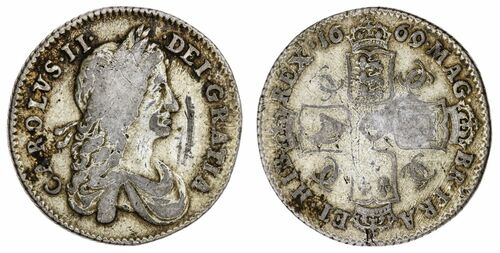
Auction: 23051 - English Milled and Hammered Coins and Artefacts
Lot: 1148
Charles II (1660-1685), Shilling, 1669 over 6, first laureate and draped bust variety right, rev. four crowned shields cruciform, eight strings to Irish harp, edge obliquely milled. 5.91g, 6h (Marshall 82(b) = Murchison 397 = Rishton 138(b) = Brice = Montagu 810 = Murdoch 602 ["Unique"]; Woodhouse 326; Dalzell 82 = Pywell-Phillips 58 same dies; Shimmin (1983), pp. 232; Bull 515 [R6]; ESC 1031; Spink 3372), evenly circulated and lightly gilt, otherwise strictly fine, the reverse similarly so albeit for softness at Scottish shield, the edge milling residually sharp, an EXCESSIVELY RARE date, and the technical finest of the three we have been privileged to offer in these rooms since 2018
Provenance
"Reader's Rarities", Coin Monthly, February 1971
Reported to the Editor at Coin Monthly, 21 October 1970
~ From the W J James Esq. Collection ~
Corpus:
i) Pywell-Phillips: Spink 257, 30-31 October 2018, lot 58 - "the reverse very softly struck, with general light pitting to surfaces, the portrait and overdate otherwise clear, about fine/poor, but excessively rare"; Lord Hamilton of Dalzell MC, Spink 3, 21 February 1979, lot 82 - "fair, but of the highest rarity" - £260; Spink, by private treaty, 1969; Herbert Alexander Parsons, Second Collection, Glendining, 11-13 May 1954, lot* 549 [part] - "well preserved and excessively rare" - £22.0.0
ii) H Manville, Spink 9, 4 June 1980, lot 54 - "small die rust marks in obverse field, obverse good very fine, reverse nearly extremely fine, attractively toned, and of highest rarity, one of the finest known" - £900; K Woodhouse, Glendining, 11 December 1968, lot 3268 "about extremely fine, only a few specimens known" - £300.0.0
The excessive rarity of this date has been noted by auctioneers since at least the Rishton sale of 1875, but was further noted by George Marshall, pioneer of the study of English Milled coinage in a letter to W G Stearns of Boston Massachusetts, published in the Americana Numismatic Journals:
"Ward End, near Birmingham, England, July 28, 1842, Dear Sir-: I received in due course, your obliging letter of 16th ultimo, and also the copy of your Half Crown of Charles 2d, date 1668, for which I beg you will accept my best thanks. My friend, Mr. J D Cuff of London, who has one of the best, if not the very best collections of English and Saxon Coins, was so fortunate as to meet with one of this date in August 1838; this with your own are the only ones I have yet heard of, but the fact is that before any publication of my work, no attention has been paid to dates by any previous author except Snelling, whose works though very valuable in many respects, and now very scarce, are not much to be relied upon as to dates. Since the publication of my book, much attention has been given to this subject, and some few dates before unknown, have made their appearance.
I saw your letter to Dr. Bowditch of 18th March 1840, in answer to some enquiries he had made respecting the early history of the coins of your country, and which letter was read before the Numismatic Society of London on 2d May, 1840 and was published in the Numismatic Chronicle, in October of the same year. I was there first acquainted with the fact of your possessing the Half-Crown of 1668. The only dates which have occurred since my book was published , and which have come to my knowledge, are as follows: - viz: Charles 2d, Crown, 1665; Half Crown 1668; Shilling, 1669; do. 1681 without the Elephant and Castle under the head. William 3d Sixpence without Roses or Feathers on the reverse. William 4th Half Crown and Shilling both dated 1837. These are I believe all in the English series which are known except what are mentioned in my View of the Silver Coin, &c. I remain, dear Sir, Your much obliged servant, GEORGE MARSHALL."
The number of 1668-dated Halfcrowns now known renders its classification as a more lowly "R2" according to Maurice Bull, although three have passed through our rooms since 2018 in various specialised cabinets. Marshall could sadly only muster 'an electro type of 1668', possibly that which Stearns had sent him from Boston in his sale in 1852 (cf. lot 71 part). He did however manage to purloin an example of the 1669 Shilling (cf. lot 82), which was acquired by William Webster, latterly of Messrs Spink, for Captain Sir Roderick Impey Murchison (1864, lot 397 part]; at whose sale he repeated the feat as a commission agent for John Edward Makon Rishton (SO, 13 July 1875, lot 138 - £3.12.6); wherein for a third time Webster bought it for William Brice. Unbelievably when Brice sold his collection en bloc to Hyman Montagu in 1887, Webster would follow the coin to his new career at Spink where he would handle it for a fourth time in cataloguing it for the Sotheby's dispersals (1896/97); and a fifth time for the John Gloag Murdoch sale (1903/04) where it would be bought for £4.13.0 by Spink commission bidder, the Marquess of Bute.
Subject to 20% VAT on Buyer’s Premium. For more information please view Terms and Conditions for Buyers.
Sold for
£1,500
Starting price
£1200




